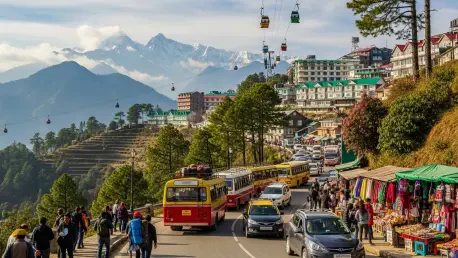Imagine a scene where the misty hills of Darjeeling and Kalimpong buzz with eager tourists, their spirits undampened by the looming threats of landslides and flooding that have battered North Bengal, showcasing the enduring allure of these destinations. Despite blocked roads and washed-out paths, these iconic hill stations remain vibrant with visitors flocking to witness their timeless charm during the festive seasons of Durga Puja and Diwali. This enduring appeal amidst adversity speaks volumes about the resilience of hill station tourism, a vital economic and cultural lifeline for the region. This analysis delves into the trends showcasing this tenacity, explores real-world impacts, incorporates expert insights, speculates on future prospects, and distills key takeaways from this remarkable phenomenon.
The Unyielding Appeal of Hill Station Tourism
Persistent Visitor Numbers Despite Natural Challenges
Hill stations like Darjeeling and Kalimpong have demonstrated an extraordinary ability to draw tourists even when nature unleashes its fury. During the festive seasons, visitor numbers have held steady, with thousands braving disrupted travel routes to soak in the scenic beauty and cultural festivities. Reports indicate a consistent flow of domestic and international travelers, undeterred by the heavy rainfall and subsequent landslides that have plagued North Bengal.
This trend of sustained arrivals highlights a deeper attachment to these destinations, where the allure of misty peaks and vibrant local traditions overshadows temporary setbacks. The festive pull, especially during major celebrations, acts as a powerful motivator, ensuring that hotels and homestays remain bustling despite the odds stacked against smooth travel.
Demonstrations of Endurance in Tough Conditions
A striking example of this resilience can be seen in the trekkers who continue their arduous journeys toward Sandakphu, the highest point in the Darjeeling hills. Unfazed by weather warnings and rugged terrain, these adventurers press on, embodying the spirit of determination that defines tourism in the region. Their persistence paints a picture of unwavering commitment to experiencing the unparalleled vistas these hills offer.
In stark contrast, regions like Dooars and Terai have not fared as well, grappling with severe flooding that has led to widespread cancellations in bookings. While Darjeeling and Kalimpong stand firm as bastions of tourist activity, the low-lying areas suffer significant losses, revealing the uneven impact of natural disasters across North Bengal’s diverse topography. This disparity underscores how geography plays a crucial role in shaping tourism outcomes during crises.
Insights from Industry and Community Stakeholders
Voices from the ground paint a vivid picture of why hill stations retain their magnetic pull despite recurring challenges. Local tour operators emphasize the unique blend of natural splendor and cultural richness that keeps visitors coming back, even when travel conditions are less than ideal. They note that the festive seasons act as a catalyst, transforming potential downturns into opportunities for economic boosts through heightened tourist engagement.
Hospitality leaders and government officials echo this sentiment, stressing the importance of disaster preparedness to sustain traveler confidence. They point to the need for robust systems to manage crises, ensuring that tourists feel safe and supported. Collaborative efforts, such as rapid road clearance and emergency helplines, are often cited as critical in maintaining the region’s reputation as a reliable destination.
Challenges like infrastructure damage remain a significant concern, yet there is a shared resolve to address them through collective action. Stakeholders highlight ongoing initiatives to repair roads and bolster safety measures, reflecting a proactive stance. Their insights reveal a consensus that while obstacles persist, the combined efforts of communities and authorities are pivotal in upholding the tourism sector’s vitality.
Future Prospects for Hill Station Tourism Resilience
Looking ahead, the sustainability of tourism in hill stations like Darjeeling and Kalimpong under recurring natural calamities remains a topic of keen interest. With weather predictions indicating continued rainfall in certain areas, the long-term viability of these destinations hinges on strategic planning and investment in resilient infrastructure. The ability to adapt to such adversities could define the future trajectory of this sector.
Advancements in disaster management hold promise for bolstering this resilience. Improved road networks, enhanced emergency services, and better early warning systems could significantly mitigate the impact of natural disasters, ensuring smoother access for tourists. Such developments would not only protect economic interests but also reinforce trust among visitors, encouraging repeat visits even in uncertain times.
However, challenges like unpredictable weather patterns loom large, potentially disrupting travel plans and affecting local livelihoods dependent on tourism. Despite these hurdles, positive outcomes are emerging, with growing visitor confidence fueled by effective crisis responses. If stakeholders continue to prioritize preparedness, the hill stations could solidify their status as enduring escapes, capable of weathering any storm.
Key Takeaways on Tourism Amid Adversity
Reflecting on the journey, it is clear that Darjeeling and Kalimpong stand as exemplars of resilience, having maintained robust tourist arrivals despite severe weather disruptions across North Bengal. Their ability to attract crowds during trying times speaks to an intrinsic charm that transcends logistical barriers, marking a significant trend in hill station tourism.
The critical role of community effort, governmental intervention, and traveler determination becomes evident as foundational pillars that uphold this sector during adversity. Their combined strength ensures that the economic and cultural heartbeat of these regions continues to pulse vibrantly, even as nature poses relentless challenges.
Moving forward, stakeholders are encouraged to channel resources into robust infrastructure and comprehensive disaster preparedness plans to safeguard this vital industry. By focusing on sustainable solutions and proactive measures, the future of hill station tourism can be secured, promising enduring appeal and stability for generations to come.









